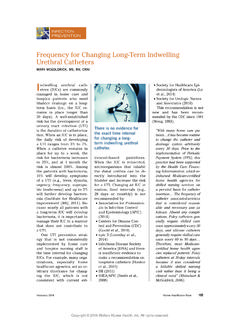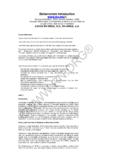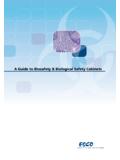Transcription of Personal Protective Equipment - Home Care and …
1 INFECTION PREVENTION112 Volume 33 | Number 2 Protective EquipmentMARY MCGOLDRICK, MS, RN, CRNI employee(s) with occupational exposure risk ( , reasonably anticipated skin, eye, mucous membrane, parenteral contact with blood or other potentially infectious materials that may result from the performance of the staff s duties; OSHA, 2014a) and requires the use of PPE. In 1993, the American Dental Association v. Martin decision upheld the bloodborne patho-gens standard but restricted its application to the home healthcare services industry. The court held that OSHA had not adequately considered feasibility problems, where edgeable and proficient in the donning and doffing of PPE, which is best achieved through repeated practice.
2 When staff receive their OSHA blood-borne pathogens training dur-ing orientation and annually thereafter, training does not typically include a demonstra-tion of competency in the use of PPE, including its donning and doffing. It is suggested that training be expanded to include competency in how to don the PPE, adjust it for proper fit and wear, and how to take it off ( , doff). For home care organizations that are ac-credited by The Joint Commis-sion, standard EP 3 requires that written infection prevention and control goals include limiting unprotected exposure to pathogens (The Joint Commission, 2014). The organization can use the data it collects when assessing the staff s competence in donning and doffing PPE to determine whether the targeted goal was are required to know: how to recognize tasks that may involve exposure to blood or other poten-tially infectious materials and when PPE must be used; what kind of PPE is to be used; how to properly don PPE, adjust it, wear it, take it off, and dispose of it; the limitations of the PPE.
3 And how to care for the PPE, maintain it, and how long it can be workers contract-ing Ebola virus disease (Ebola) after caring for a patient with Ebola heightens the need for all home care and hospice providers to be aware of how to use Personal Protective equip-ment (PPE) properly and the risks for self-contamination when removing PPE. The home is not a suitable environment for caring for patients with symptoms of Ebola under rou-tine, nonpandemic conditions, and as such, this article will not address the Centers for Disease Control and Prevention s guide-lines for the use of PPE when caring for a patient with Ebola. When caring for home care or hospice patients, there are other pathogens ( , Clostrid-ium difficile, carbapenem- resistant Enterobacteriaceae, and vancomycin-resistant en-terococci) that patients may be infected or colonized with that may require the use of PPE.
4 This article will review the principles of PPE used by home care and hospice staff and reinforce the need for carefully removing and discarding the PPE used during patient care to prevent and con-trol the transmission of infec-tious Occupational Safety and Prevention Administra-tion (OSHA) bloodborne pathogens standard applies to all employers who have an The Occupational Safety and Prevention Administration bloodborne pathogen standard requires that home care or hospice organizations provide Personal Protective Equipment to their staff and ensure proper use through work at sites over which the employer does not have control. OSHA determined that the employer will not be held responsible for site-specific re-quirements of the bloodborne pathogen standard ( , ensur-ing the use of PPE).
5 However, the home healthcare agency is responsible for all non site-specific requirements of the standard, including the non site-specific requirements of training and providing appro-priate PPE to all staff at risk (OSHA, 2014b).The OSHA bloodborne pathogen standard requires that home care or hospice organizations provide PPE to their staff and ensure proper use through training. Training ensures that staff are knowl-Copyright 2015 Wolters Kluwer Health, Inc. All rights 2015 Home Healthcare Now 113 Although using PPE is im-portant, it is also essential that staff don and remove PPE in a manner that minimizes further spread of contamination. The combination of PPE selected will affect the sequence of don-ning and removal. When the home care and hospice staff are trained, the following basic principles must be observed to ensure the safe and effective use of the PPE.
6 Donning: PPE must be donned correctly in the proper order before going into the home, immedi-ate patient care area in the home, or room when providing facility-based hospice care. The level of risk for exposure to blood or other potentially infec-tion materials will deter-mine the kind of PPE that will be used and the loca-tion of where it should be don PPE: 1. Inspect the PPE before donning; looking for tears, holes, or other damage. 2. Don a gown that fully cov-ers the torso from the neck to the knees, arms to the end of the wrists, and wraps around to the back. Fasten the gown in the back of the neck and waist. 3. Don a mask or respira-tor and secure the ties or elastic bands at the middle of the head and neck. Fit the flexible band to the bridge of the nose; snug on the face and below the chin.
7 If using a respirator, perform a fit check. 4. Don a face mask or gog-gles, place it over the face and eyes, and adjust it to fit. 5. Don gloves that extend to cover the wrist (of the isolation gown, if worn). During patient care: PPE must remain in place, be worn correctly for the duration of the potential exposure to blood or other potentially infectious ma-terials, and should not be adjusted during patient care. Keep the hands away from the face and limit the surfaces touched. If the gloves become heav-ily contaminated, or their ability to function as a bar-rier is compromised ( , the glove rips or a needle-stick occurs), the staff member must immediately remove the gloves, per-form hand hygiene, change the PPE if continuing care, or as applicable, imple-ment the organization s plan for an occupational exposure to blood or other potentially infectious materials.
8 Doffing: PPE must be re-moved in a slow, deliber-ate, systematic manner in the correct sequence before leaving the patient s immediate care area. If a respirator is worn, it should be removed after leaving the area for care. Removing PPE is a high-risk procedure in which the staff may be exposed to pathogenic organisms through self-contamination. PPE should be disposed of in the home as household waste, unless state laws or regulations require it to be disposed of as regulated medical waste. Examples of meth-ods to safely remove PPE in the proper sequence can be viewed at (CDC, 2014).As a reminder, wearing gloves is not a substitute for performing hand hygiene after removing PPE. If the hands be-come visibly contaminated dur-ing PPE removal, hand hygiene should be performed before continuing to remove PPE.
9 Staff need to be very careful when removing PPE so that their skin and clothing do not become contaminated. Mary McGoldrick, MS, RN, CRNI, is a Home Care and Hospice Consultant, Home Health Systems, Inc., Saint Simons Island, author declares no conflicts of for correspondence: Mary McGoldrick, MS, RN, CRNI, Box 21704, Saint Simons Island, GA 31522 for Disease Control and Preven-tion. (2014, October 21). Guidance on Personal Protective Equipment to be used by healthcare workers during man-agement of patients with Ebola Virus Disease in Hospitals, including procedures for putting on (donning) and removing (doffing). Retrieved from Safety and Health Admin-istration. (2014a). Quick reference guide to the bloodborne pathogens standard.
10 Retrieved from Safety and Health Adminis-tration. (2014b). Enforcement proce-dures for the occupational exposure to bloodborne pathogen. Retrieved from #XIThe Joint Commission. (2014). Infection prevention and control. Comprehensive Accreditation Manual for Home Care (pp. IC-6). Oakbrook Terrace, IL: 2015 Wolters Kluwer Health, Inc. All rights reserved.









